engine coolant Mercury Mountaineer 1997 Owner's Manuals
[x] Cancel search | Manufacturer: MERCURY, Model Year: 1997, Model line: Mountaineer, Model: Mercury Mountaineer 1997Pages: 197, PDF Size: 2.08 MB
Page 4 of 197
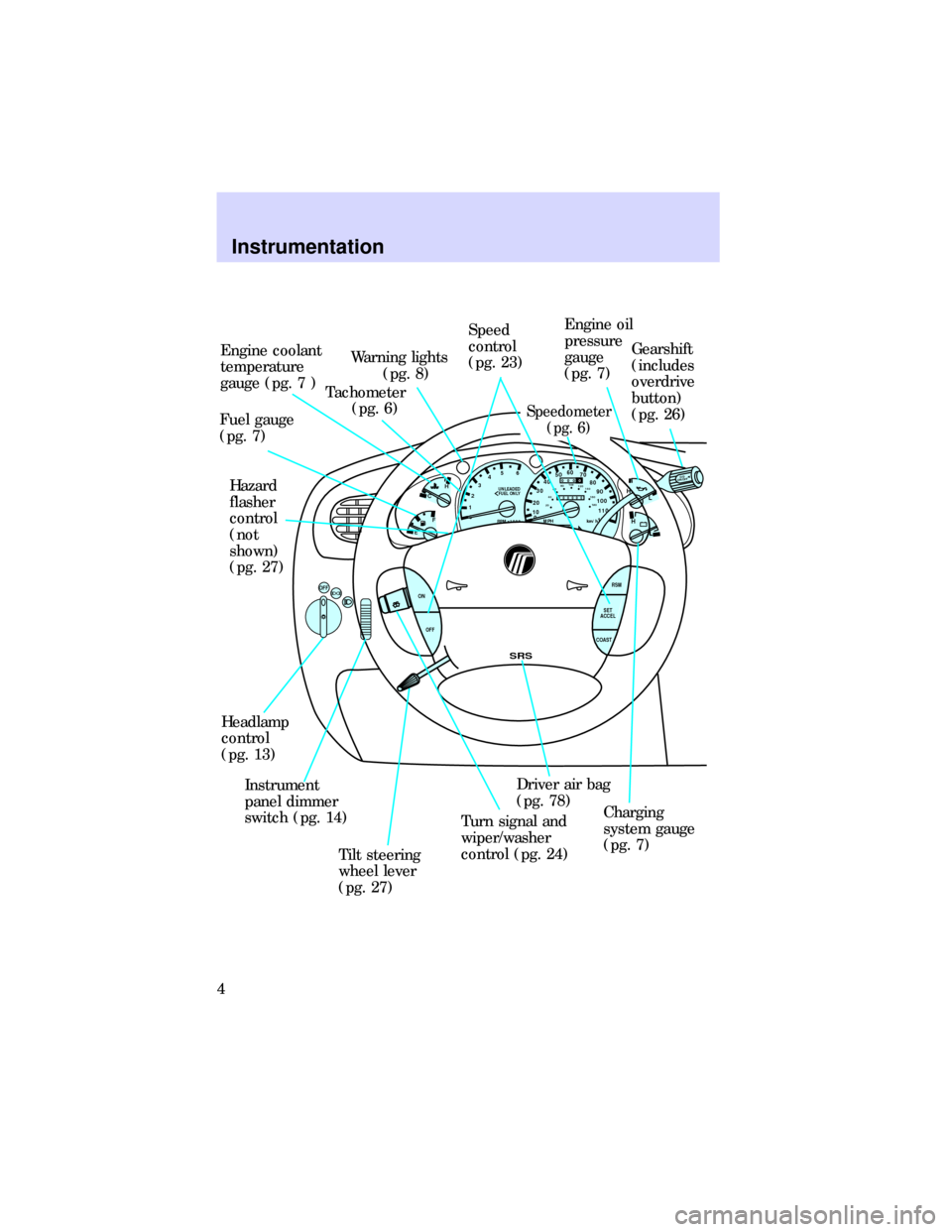
L
0P RND21
UNLEADED
FUEL ONLY
RPM x 1000
12345
6
H
C
F
E
RSM
SET
ACCEL
COAST OFFOFF
SRS
- +
H
H
L L
ON
020
1030405060
70
80
90
110
120000000
oooo
km/h MPH
100
20406080100
120
140
160
180
O/D
ON/OFF
Engine coolant
temperature
gauge (pg. 7 )
Tachometer
(pg. 6) Warning lights
(pg. 8)Speed
control
(pg. 23)
Speedometer
(pg. 6)
Engine oil
pressure
gauge
(pg. 7)Gearshift
(includes
overdrive
button)
(pg. 26)
Charging
system gauge
(pg. 7) Driver air bag
(pg. 78)
Turn signal and
wiper/washer
control (pg. 24)
Tilt steering
wheel lever
(pg. 27) Instrument
panel dimmer
switch (pg. 14) Headlamp
control
(pg. 13)Hazard
flasher
control
(not
shown)
(pg. 27) Fuel gauge
(pg. 7)
Instrumentation
4
Page 7 of 197
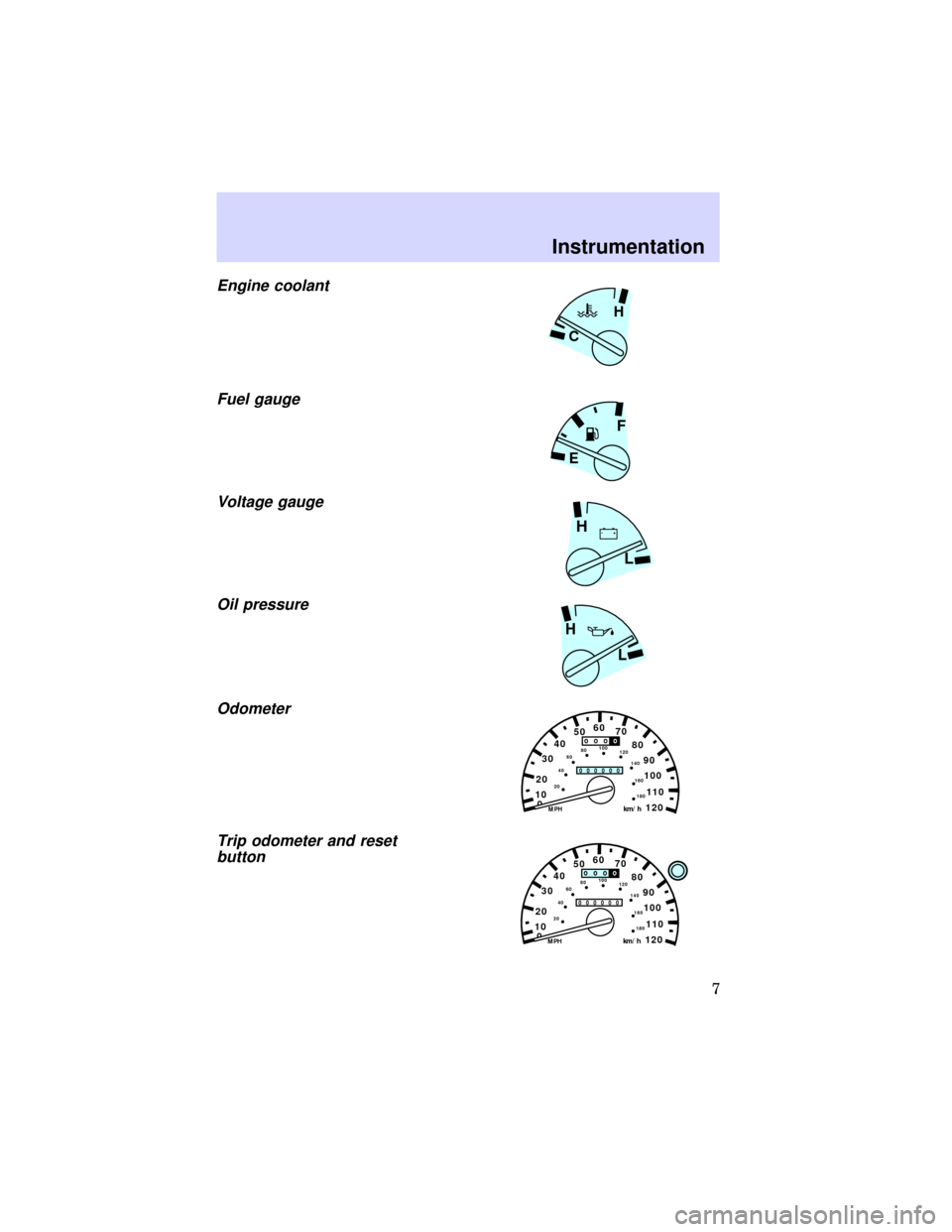
Engine coolant
Fuel gauge
Voltage gauge
Oil pressure
Odometer
Trip odometer and reset
button
H
C
F
E
- +H
L
H
L
0
20
1030405060
70
80
90
110
120000000
oooo
100
km/hMPH
20406080100
120
140
160
180
0
20
1030405060
70
80
90
110
120000000
oooo
100
km/hMPH
20406080100
120
140
160
180
Instrumentation
7
Page 93 of 197

2. Press the accelerator all the way
to the floor and hold.
3. Turn the key to START. Release
it once the engine starts.
4. Release the accelerator
gradually as the engine speeds up.
If the engine still does not start,
refer toFuel pump shutoff
switchin theRoadside
emergencieschapter.
Engine block heater (if
equipped)
To prevent electrical
shock, do not use your
engine block heater with
ungrounded electrical systems or
two-pronged (cheater) adapters.
Engine block heaters are strongly
recommended if you live in a
region where temperatures reach
-23ÉC (-10ÉF) or below. An engine
block heater works by warming the
engine coolant. This improves
engine starting by warming the
engine faster. Engine block heater
operation also allows the heater
and defrost system to respond
more quickly than usual.
Starting your vehicle
93
Page 139 of 197
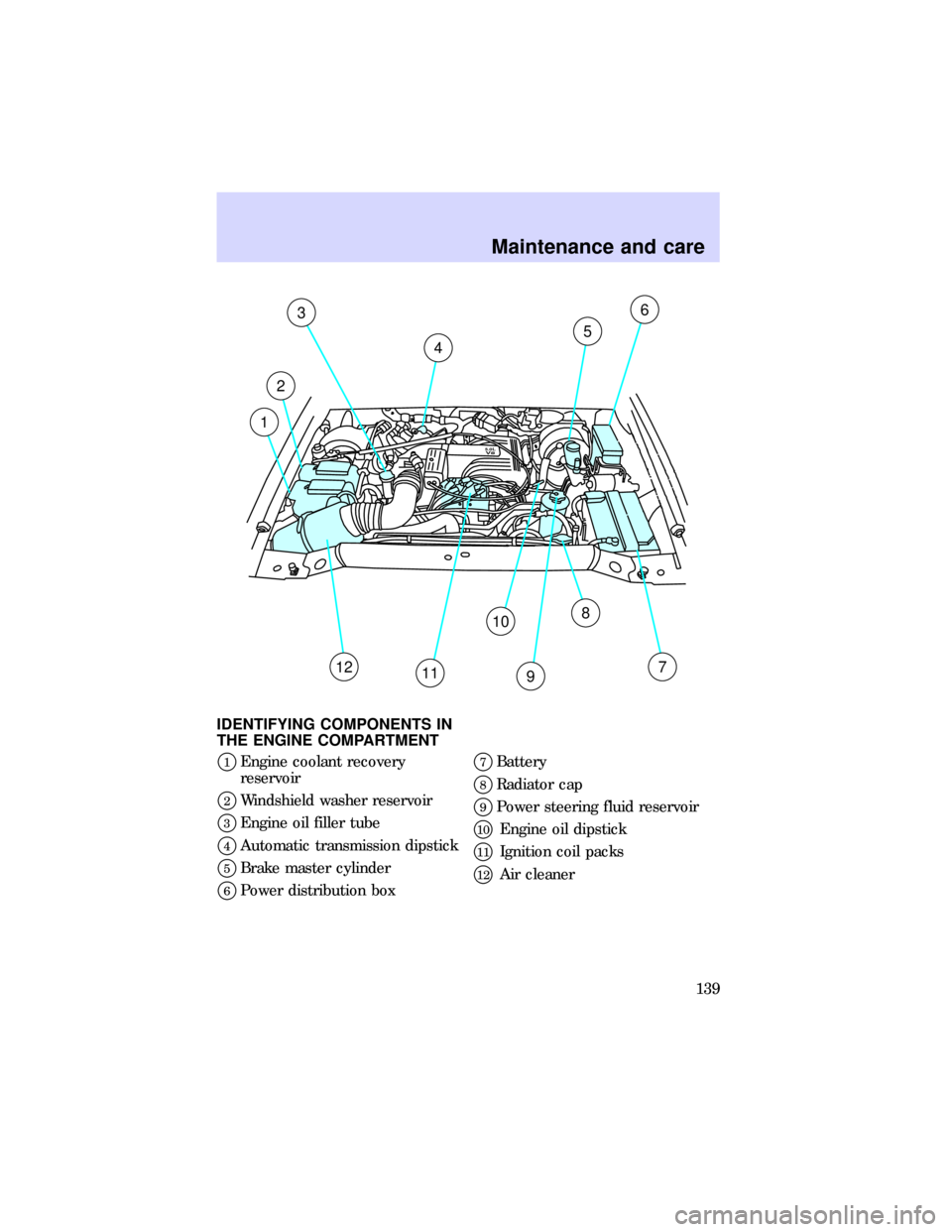
IDENTIFYING COMPONENTS IN
THE ENGINE COMPARTMENT
V1Engine coolant recovery
reservoir
V2Windshield washer reservoir
V3Engine oil filler tube
V4Automatic transmission dipstick
V5Brake master cylinder
V6Power distribution box
V7Battery
V8Radiator cap
V9Power steering fluid reservoir
V10Engine oil dipstick
V11Ignition coil packs
V12Air cleaner
3
4
5
6
2
1
1211
108
79
5.0L
V8
Maintenance and care
139
Page 145 of 197
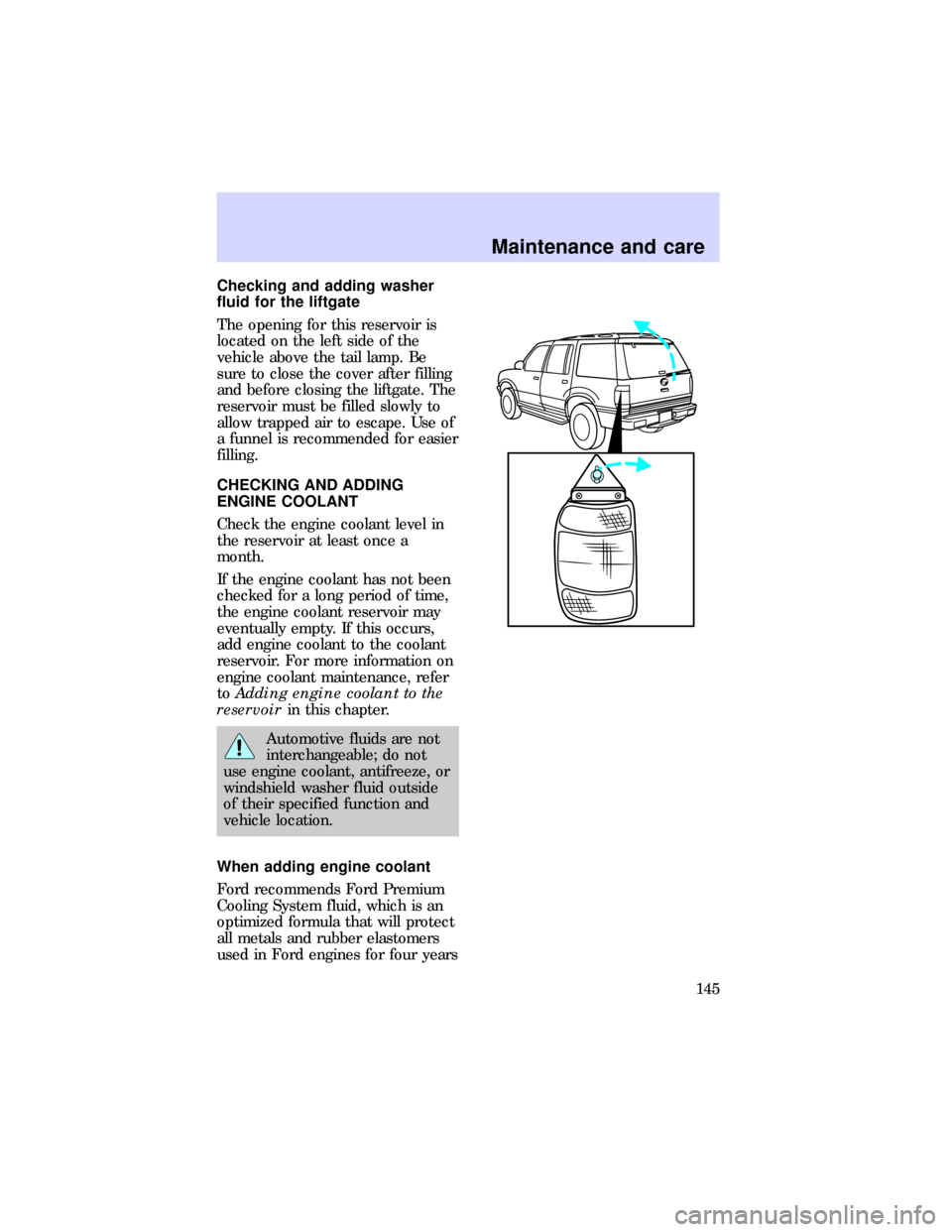
Checking and adding washer
fluid for the liftgate
The opening for this reservoir is
located on the left side of the
vehicle above the tail lamp. Be
sure to close the cover after filling
and before closing the liftgate. The
reservoir must be filled slowly to
allow trapped air to escape. Use of
a funnel is recommended for easier
filling.
CHECKING AND ADDING
ENGINE COOLANT
Check the engine coolant level in
the reservoir at least once a
month.
If the engine coolant has not been
checked for a long period of time,
the engine coolant reservoir may
eventually empty. If this occurs,
add engine coolant to the coolant
reservoir. For more information on
engine coolant maintenance, refer
toAdding engine coolant to the
reservoirin this chapter.
Automotive fluids are not
interchangeable; do not
use engine coolant, antifreeze, or
windshield washer fluid outside
of their specified function and
vehicle location.
When adding engine coolant
Ford recommends Ford Premium
Cooling System fluid, which is an
optimized formula that will protect
all metals and rubber elastomers
used in Ford engines for four years
Maintenance and care
145
Page 146 of 197
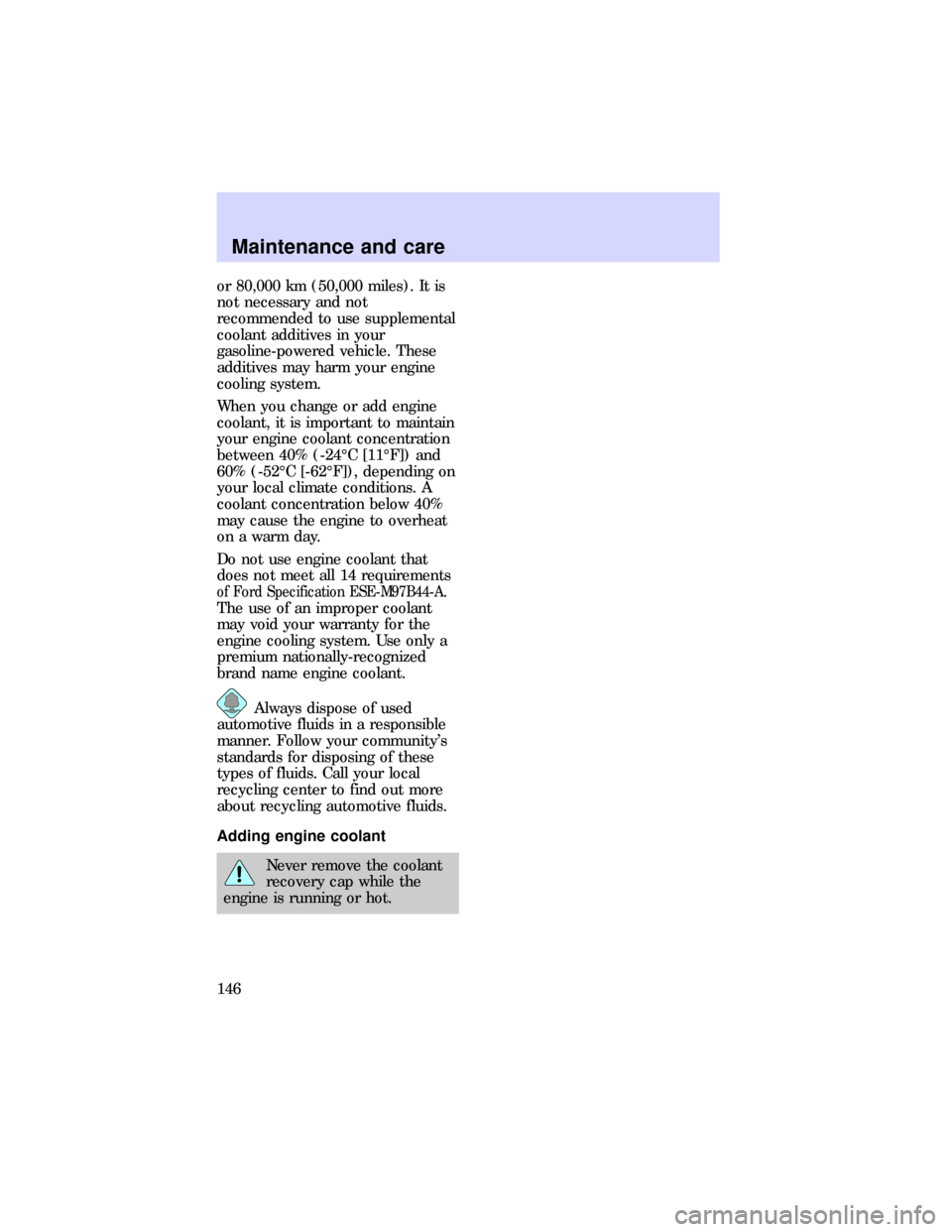
or 80,000 km (50,000 miles). It is
not necessary and not
recommended to use supplemental
coolant additives in your
gasoline-powered vehicle. These
additives may harm your engine
cooling system.
When you change or add engine
coolant, it is important to maintain
your engine coolant concentration
between 40% (-24ÉC [11ÉF]) and
60% (-52ÉC [-62ÉF]), depending on
your local climate conditions. A
coolant concentration below 40%
may cause the engine to overheat
on a warm day.
Do not use engine coolant that
does not meet all 14 requirements
of Ford Specification ESE-M97B44-A.
The use of an improper coolant
may void your warranty for the
engine cooling system. Use only a
premium nationally-recognized
brand name engine coolant.
Always dispose of used
automotive fluids in a responsible
manner. Follow your community's
standards for disposing of these
types of fluids. Call your local
recycling center to find out more
about recycling automotive fluids.
Adding engine coolant
Never remove the coolant
recovery cap while the
engine is running or hot.
Maintenance and care
146
Page 147 of 197

1. Before you remove the coolant
recovery cap, turn the engine off
and let it cool. Even when the
engine is cool, be careful when
removing the recovery cap. Wrap a
thick cloth around the cap for safe
removal.
2. When the engine is cool, lift the
cap.
3. Step back while pressure
releases.
4. When you are sure that all the
pressure has been released,
remove the recovery cap.
5. Stand away from the reservoir
opening; hot steam may blow out
or hot engine coolant may even
splash out.
6. Add engine coolant until the
level is between the MAX and MIN
lines on the engine coolant
recovery reservoir.
Follow the recommended service
interval for changing engine
coolant as outlined in theService
Guide. For coolant recovery
reservoir capacity, refer to
Lubricant specificationsin the
Capacities and specifications
chapter.
RADIATOR
COOLANT
ONLY
MAX
MIN
Maintenance and care
147
Page 148 of 197

Checking the cooling system
hoses
Before adding or replacing coolant,
inspect all cooling system hoses
for:
²deterioration
²leaks
²loose clamps
CHECKING AND ADDING
POWER STEERING FLUID
Check the power steering fluid at
least twice a year by completing
the following steps:
1. Start the engine.
2. When the engine coolant
temperature gauge reaches the
normal zone, turn off the engine.
CH
Maintenance and care
148
Page 185 of 197

MOTORCRAFT PART NUMBERS
Component Motorcraft part number
Spark plug
1AWSF-32EE*
Air filter FA-1641
Fuel filter FG-872
Oil filter FL-1A
Battery BXT-65-650 or BXT-65-850 (optional)
P.C.V. valve EV-152
1Refer to Vehicle Emission Control Information Decal for spark plug and
gap specifications.
*If any spark plug needs to be removed for examination, each spark plug
removed must be reinstalled in the same cylinder. Cylinders 1-4 have an
ªEGº suffix. Cylinders 5-8 have an ªEº suffix. If any spark plug needs to
be replaced, use only spark plugs with the service part number suffix
letters ªEEº as shown on the engine decal.
REFILL CAPACITIES
Fluid Component Capacity
Brake fluid Brake master
cylinderFill to line in
reservoir
1
Engine coolant Engine coolant
recovery reservoir
and radiator13.5 L (12.8 qts.)
Engine oil 5.0 L (302 c.i.d.) 4.7 L (5.0 qts.)
2
Fuel 4-door 79.5 L (21.0 gal)
Front axle Dana 35 front axle 1.7 L (3.5 pts.)
1
Power steering fluid Power steering fluid
reservoirFill to line in
reservoir1
Rear axle Ford conventional
and Traction Lok 8.82.6 L (5.5 pts.)1
Capacities and specifications
185
Page 189 of 197

ComponentFord part
nameFord part
numberFord
specification
Engine coolant Premium
Cooling System
FluidE2FX-19549-AA ESE-M97B44-A
Transfer case
front output
slip shaftPremium
Long-Life
GreaseXG-1-C or K ESA-M1C75-B
Transfer case Motorcraft
MERCONtAT FXT-2-QDX MERCONt
Dana 35 front
drive axle4x4 Gear Oil F1TZ-19580-A WSL-M2C191-A
1Add 118 ml (4oz.) of EST-M2C118-A Friction Modifier (part number
C8A2-19B546-A) for complete refill of Ford Traction-Lok rear axles.
ENGINE DATA
Engine5.0L (302 CID) OHV V-8
Displacement5.0L (302 CID)
Bore x Stroke10.16 x 7.62 cm (4.00 x 3.00 in.)
InductionPCM controlled sequential port fuel injection
IgnitionPCM controlled distributorless electronic
Firing order1-3-7-2-6-5-4-8
Spark plug gap1.3 - 1.4 mm (.052 - .056 in.)
Horsepower210 HP
Torque366.1 Nzm (270 lb/ft)
Compression ratio8.8:1
Capacities and specifications
189